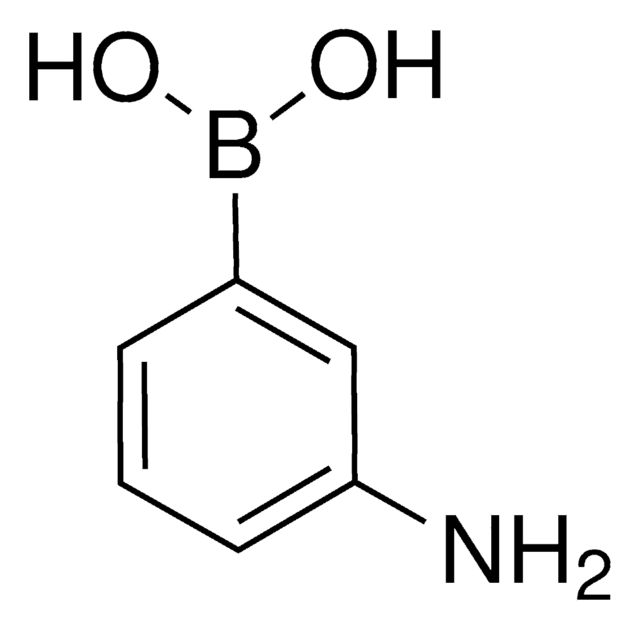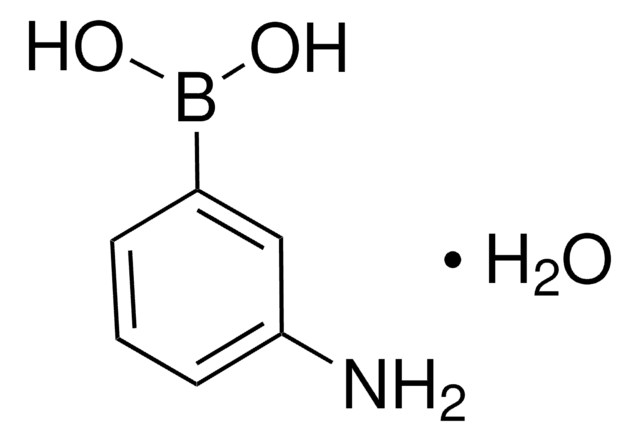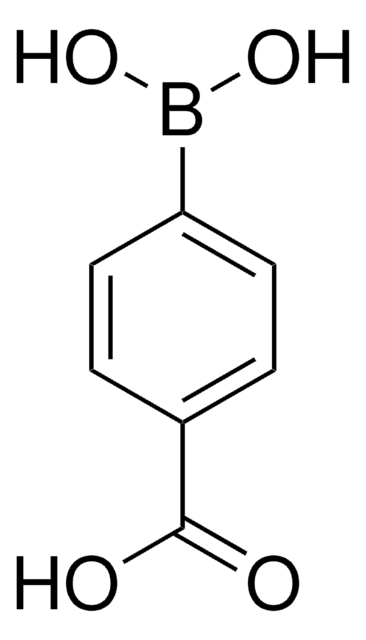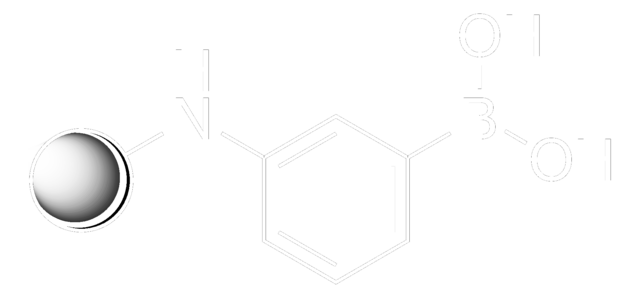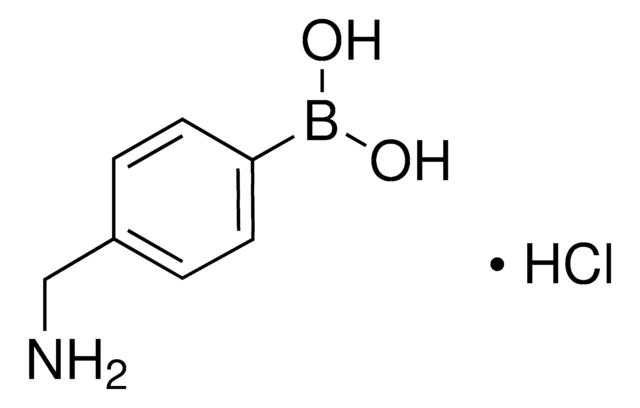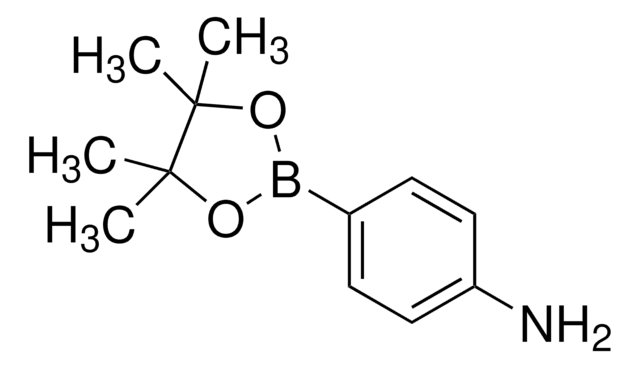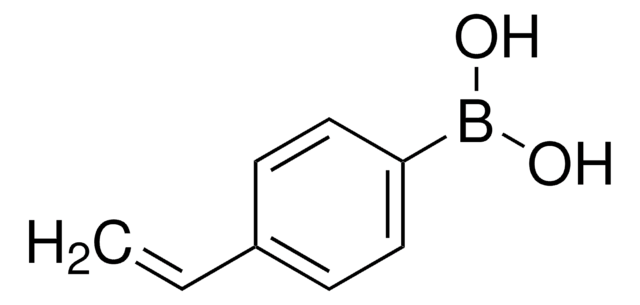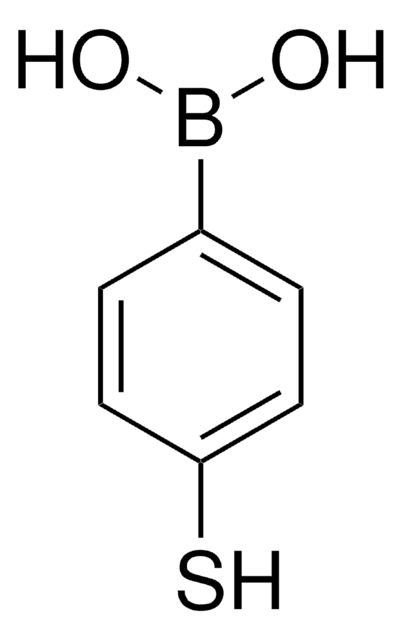410705
3-Aminophenylboronic acid hydrochloride
98%
Sinonimo/i:
(m-Aminophenyl)boronic acid hydrochloride, 3-Aminobenzeneboronic acid hydrochloride
Autenticatiper visualizzare i prezzi riservati alla tua organizzazione & contrattuali
About This Item
Formula condensata:
H2NC6H4B(OH)2 · HCl
Numero CAS:
Peso molecolare:
173.41
Numero CE:
Numero MDL:
Codice UNSPSC:
12352103
ID PubChem:
NACRES:
NA.22
Prodotti consigliati
Livello qualitativo
Saggio
98%
Forma fisica
powder
Stringa SMILE
Cl.Nc1cccc(c1)B(O)O
InChI
1S/C6H8BNO2.ClH/c8-6-3-1-2-5(4-6)7(9)10;/h1-4,9-10H,8H2;1H
QBMHZZHJIBUPOX-UHFFFAOYSA-N
Descrizione generale
3-Aminophenylboronic acid hydrochloride is a boronic acid derivative that is commonly used as a reagent in Suzuki-Miyaura coupling reactions, where it can be used to form C-C bonds by the reaction with aryl or vinyl halides. It can also be used in other cross-coupling reactions, such as copper-catalyzed coupling reactions, as well as in palladium-free cross-coupling reactions.
Applicazioni
3-Aminophenylboronic acid hydrochloride was used as a key reagent used in the synthesis of the boronic acid ester starting material, which is subsequently converted to the cyclobutene precursor through a Heck coupling reaction. It is also used as a boronic acid source in the synthesis of boronate-functionalized monomers. These monomers are further used in the preparation of reproducible and high-quality polymer films.
Avvertenze
Warning
Indicazioni di pericolo
Consigli di prudenza
Classi di pericolo
Eye Irrit. 2 - Skin Irrit. 2 - STOT SE 3
Organi bersaglio
Respiratory system
Codice della classe di stoccaggio
11 - Combustible Solids
Classe di pericolosità dell'acqua (WGK)
WGK 3
Punto d’infiammabilità (°F)
Not applicable
Punto d’infiammabilità (°C)
Not applicable
Dispositivi di protezione individuale
dust mask type N95 (US), Eyeshields, Gloves
Scegli una delle versioni più recenti:
Possiedi già questo prodotto?
I documenti relativi ai prodotti acquistati recentemente sono disponibili nell’Archivio dei documenti.
I clienti hanno visto anche
Na Wu et al.
Nanoscale, 12(42), 21687-21694 (2020-10-24)
High-performance electrocatalysts for the methanol oxidation reaction (MOR) are the key to advance the application of direct methanol fuel cells. Pt-Based electrocatalysts for the MOR are limited due to their high cost, low stability and poor resistance to carbon monoxide
Elita Montanari et al.
Macromolecular bioscience, 16(12), 1815-1823 (2016-10-14)
Nanoparticles based on hyaluronic acid (HA) are designed to deliver tannic acid (TA) as an antimicrobial agent. The presence of HA makes these particles potentially useful to target bacteria that colonize cells presenting HA membrane receptors (e.g. CD44), such as
Chao Ding et al.
Chemistry (Weinheim an der Bergstrasse, Germany), 23(59), 14883-14888 (2017-08-05)
Stimuli-responsive polymer materials inspired by biological materials have invoked increasing research interest; however, they still suffer from limitations such as finite amplified responses and poor sensitivity of the unstimulated parts. Herein, a new strategy for creating H
Il team dei nostri ricercatori vanta grande esperienza in tutte le aree della ricerca quali Life Science, scienza dei materiali, sintesi chimica, cromatografia, discipline analitiche, ecc..
Contatta l'Assistenza Tecnica.